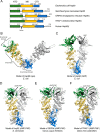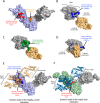Hsp90 and Hsp70 chaperones: Collaborators in protein remodeling - PubMed (original) (raw)
Review
Hsp90 and Hsp70 chaperones: Collaborators in protein remodeling
Olivier Genest et al. J Biol Chem. 2019.
Abstract
Heat shock proteins 90 (Hsp90) and 70 (Hsp70) are two families of highly conserved ATP-dependent molecular chaperones that fold and remodel proteins. Both are important components of the cellular machinery involved in protein homeostasis and participate in nearly every cellular process. Although Hsp90 and Hsp70 each carry out some chaperone activities independently, they collaborate in other cellular remodeling reactions. In eukaryotes, both Hsp90 and Hsp70 function with numerous Hsp90 and Hsp70 co-chaperones. In contrast, bacterial Hsp90 and Hsp70 are less complex; Hsp90 acts independently of co-chaperones, and Hsp70 uses two co-chaperones. In this review, we focus on recent progress toward understanding the basic mechanisms of Hsp90-mediated protein remodeling and the collaboration between Hsp90 and Hsp70, with an emphasis on bacterial chaperones. We describe the structure and conformational dynamics of these chaperones and their interactions with each other and with client proteins. The physiological roles of Hsp90 in Escherichia coli and other bacteria are also discussed. We anticipate that the information gained from exploring the mechanism of the bacterial chaperone system will provide the groundwork for understanding the more complex eukaryotic Hsp90 system and its modulation by Hsp90 co-chaperones.
Keywords: Hop/Sti1; Hsp40; HtpG; chaperone DnaJ (DnaJ); chaperone DnaK (DnaK); client protein; co-chaperone; conformational change; heat shock protein (HSP); protein folding.
Conflict of interest statement
The authors declare that they have no conflicts of interest with the contents of this article
Figures
Figure 1.
Domain organization in Hsp90 homologs is conserved. A, Hsp90 protomers contain an NTD (green) that is involved in ATP binding and hydrolysis and interaction with some clients; an MD (yellow) that is involved in client binding and direct interaction with Hsp70; and a CTD (blue) that contains the dimerization region and is involved in client binding. A charged, flexible linker of variable length connects the NTD and MD. The C-terminal extension with the MEEVD residues that allow binding with co-chaperones containing a TPR domain is indicated for yeast Hsp82 and human Hsp90β. B, model of the crystal structure of the E. coli Hsp90 dimer in the apo form (PDB code 2IOQ) (32) with the C-terminal domains aligned to the crystal structure of the isolated C-terminal domain (PDB code 1SF8) (19). C, dimer structure of E. coli Hsp90 in the ADP-bound conformation (PDB code 2IOP) (32). D, dimer structure of Saccharomyces cerevisiae Hsp82 in the AMP-PNP–bound conformation (PDB code 2CG9) (41). E, dimer structure of Canis lupus familiaris endoplasmic reticulum Hsp90, GRP94, in the AMP-PNP–bound conformation (PDB code 5ULS) (30). F, dimer structure of Danio rerio (zebrafish) mitochondrial Hsp90, TRAP1, in the AMP-PNP–bound conformation (PDB code 4IPE) (31). B–F, all images were prepared using PyMOL, and the domains are colored as in A. C–F, bound nucleotide is shown in black as CPK models.
Figure 2.
Hsp70/DnaK chaperone. A and B, structures of E. coli Hsp70, DnaK, in the closed (A) ADP-bound conformation (PDB code 2KHO) (61) and in the open (B) ATP-bound conformation (PDB code 4B9Q), which is stabilized in an oxidized triple mutant (E47C, T199A, and F529C) in the presence of ATP (67). The DnaK protomer contains an NBD (gray) connected by a flexible linker (blue) to an SBD that is made up of two subdomains, an α-helical subdomain, the “lid” (teal), and a β-sheet subdomain that contains the substrate-binding site (purple). B, ATP is shown in black as a CPK model. C, cartoon representation of substrate interaction and remodeling by DnaK. First, misfolded substrate interacts with ATP-bound DnaK, which is in the low-affinity substrate–binding state (step 1). A J-domain protein, either DnaJ or CbpA, interacts with and stimulates ATP hydrolysis by DnaK (step 2), converting DnaK to the ADP-bound high–affinity substrate–binding state. NEF/GrpE promotes nucleotide exchange, from ADP to ATP, via direct interactions with DnaK (step 3). The substrate is then released and can fold into the native conformation (step 4) or be rebound by DnaK. In A and B the images were prepared using PyMOL.
Figure 3.
Regions of interaction on Hsp90 and Hsp70. A, surface-rendered model of the Hsp90Ec full-length dimer in the apo conformation was built from the biological assembly 1 of PDB code 2IOP (32) using CHARMM to build in missing atoms (12) and shows one protomer in gray and the other protomer in light blue. The site of DnaK interaction on the MD is shown in red (11), and the site of client binding in the MD and CTD is shown in orange (20). B, surface rendering of DnaK in the ADP-bound conformation (PDB code 2KHO) (61); the NBD is in gray, and the SBD is composed of two subdomains, an α-helical subdomain and a β-sheet subdomain in light orange. The site of Hsp90Ec interaction on the NBD is shown in blue (12). C, surface rendering of DnaK in the ADP-bound conformation as in B but showing the DnaJ interaction region in green (83, 92–95). D, surface rendering of DnaK in the ATP-bound conformation (PDB code 4B9Q) (67) showing the change in position of the SBD α-helical and β-sheet subdomains (light orange) relative to the NBD (gray) and the Hsp90Ec-interacting residues (blue). E, docked surface-rendered model of the apo structure of Hsp90Ec (shown in A) and a cartoon model of ADP-bound DnaK (shown in B) (12). The Hsp90Ec dimer is shown with one protomer in gray, one in light blue, and the DnaK-interacting region in the MD shown in red. DnaK in shown in light orange with Hsp90Ec-interacting residues in the NBD shown in blue as CPK models. F, docked homology models of apo yeast Hsp82 and ADP-bound Ssa1 (18). The Hsp82 dimer is shown as a surface-rendered model in gray and light green with the Ssa1-binding region on the M-domain shown in red. A cartoon model of Ssa1 is shown in blue. All images were prepared using PyMOL.
Figure 4.
Models for the mechanisms of action of Hsp90. A, working model for protein remodeling by E. coli Hsp90 in collaboration with the E. coli Hsp70 system. First, DnaK binds client protein and in a process that requires a J-protein (DnaJ or CbpA), nucleotide-exchange factor (GrpE), and ATP initially remodels the client (step 1). Next, DnaK (in the ADP-bound conformation) recruits Hsp90Ec (in the apo conformation) to the client via a direct interaction between the DnaK NBD and the M-domain of Hsp90Ec (step 2). Because DnaJ (CbpA) interaction with DnaK in the ADP-bound conformation is weak, DnaJ (CbpA) is likely released at this step; Hsp90Ec and DnaJ (CbpA) share an overlapping binding site on DnaK suggesting that if DnaJ (CbpA) remains bound to ADP-bound DnaK, Hsp90Ec may displace it. Client is transferred to Hsp90Ec from DnaK following nucleotide exchange by DnaK (to the ATP-bound conformation) and ATP binding by Hsp90Ec (step 3). The ATP-bound conformation of DnaK likely dissociates from Hsp90Ec and conformational changes by ATP-bound Hsp90Ec lead to stabilization of client binding. After ATP hydrolysis and ADP release by Hsp90Ec, client protein is released (step 4) and can reach its active conformation either spontaneously (step 5) or it may reenter the chaperone cycle. B, working model for the holding activity of Hsp90. First, the aggregation prone client or folding intermediate is recognized by Hsp90 (step 1). Client recognition can be through one of many different client-binding sites on Hsp90 and is nucleotide-independent. The client is held by Hsp90 and prevented from aggregating by Hsp90 through a 1:1 stoichiometric interaction. Again, nucleotide is not required for this step. Next, for some clients, release occurs transiently, without the need for nucleotide, but for other clients, ATP binding, hydrolysis, and/or release may be necessary (step 2). The client may fold to its native conformation spontaneously (step 3), or it may rebind Hsp90.
Similar articles
- The Bacterial Hsp90 Chaperone: Cellular Functions and Mechanism of Action.
Wickner S, Nguyen TL, Genest O. Wickner S, et al. Annu Rev Microbiol. 2021 Oct 8;75:719-739. doi: 10.1146/annurev-micro-032421-035644. Epub 2021 Aug 10. Annu Rev Microbiol. 2021. PMID: 34375543 Review. - Intermolecular Interactions between Hsp90 and Hsp70.
Doyle SM, Hoskins JR, Kravats AN, Heffner AL, Garikapati S, Wickner S. Doyle SM, et al. J Mol Biol. 2019 Jul 12;431(15):2729-2746. doi: 10.1016/j.jmb.2019.05.026. Epub 2019 May 22. J Mol Biol. 2019. PMID: 31125567 Free PMC article. - Hsp70 and Hsp90 of E. coli Directly Interact for Collaboration in Protein Remodeling.
Genest O, Hoskins JR, Kravats AN, Doyle SM, Wickner S. Genest O, et al. J Mol Biol. 2015 Dec 4;427(24):3877-89. doi: 10.1016/j.jmb.2015.10.010. Epub 2015 Oct 23. J Mol Biol. 2015. PMID: 26482100 Free PMC article. - Uncoupling the Hsp90 and DnaK chaperone activities revealed the in vivo relevance of their collaboration in bacteria.
Corteggiani M, Bossuet-Greif N, Nougayrède JP, Byrne D, Ilbert M, Dementin S, Giudici-Orticoni MT, Méjean V, Oswald E, Genest O. Corteggiani M, et al. Proc Natl Acad Sci U S A. 2022 Sep 13;119(37):e2201779119. doi: 10.1073/pnas.2201779119. Epub 2022 Sep 7. Proc Natl Acad Sci U S A. 2022. PMID: 36070342 Free PMC article. - Hsp90, a team player in protein quality control and the stress response in bacteria.
Wickramaratne AC, Wickner S, Kravats AN. Wickramaratne AC, et al. Microbiol Mol Biol Rev. 2024 Jun 27;88(2):e0017622. doi: 10.1128/mmbr.00176-22. Epub 2024 Mar 27. Microbiol Mol Biol Rev. 2024. PMID: 38534118 Free PMC article. Review.
Cited by
- Transcriptomic Analysis Reveals Dynamics of Gene Expression in Liver Tissue of Spotted Sea Bass Under Acute Thermal Stress.
Li P, Sun Y, Wen H, Qi X, Zhang Y, Sun D, Liu C, Li Y. Li P, et al. Mar Biotechnol (NY). 2024 Dec;26(6):1336-1349. doi: 10.1007/s10126-024-10375-z. Epub 2024 Oct 21. Mar Biotechnol (NY). 2024. PMID: 39432208 - The prion-like effect and prion-like protein targeting strategy in amyotrophic lateral sclerosis.
Wenzhi Y, Xiangyi L, Dongsheng F. Wenzhi Y, et al. Heliyon. 2024 Jul 22;10(15):e34963. doi: 10.1016/j.heliyon.2024.e34963. eCollection 2024 Aug 15. Heliyon. 2024. PMID: 39170125 Free PMC article. Review. - Cytoplasmic molecular chaperones in Pseudomonas species.
Kim H, Moon S, Ham S, Lee K, Römling U, Lee C. Kim H, et al. J Microbiol. 2022 Nov;60(11):1049-1060. doi: 10.1007/s12275-022-2425-0. Epub 2022 Nov 1. J Microbiol. 2022. PMID: 36318358 Review. - Selection for Translational Efficiency in Genes Associated with Alphaproteobacterial Gene Transfer Agents.
Kogay R, Zhaxybayeva O. Kogay R, et al. mSystems. 2022 Dec 20;7(6):e0089222. doi: 10.1128/msystems.00892-22. Epub 2022 Nov 14. mSystems. 2022. PMID: 36374047 Free PMC article. - Molecular mechanisms of chaperone-directed protein folding: Insights from atomistic simulations.
Castelli M, Magni A, Bonollo G, Pavoni S, Frigerio F, Oliveira ASF, Cinquini F, Serapian SA, Colombo G. Castelli M, et al. Protein Sci. 2023 Dec 25;33(3):e4880. doi: 10.1002/pro.4880. Online ahead of print. Protein Sci. 2023. PMID: 38145386 Free PMC article.
References
Publication types
MeSH terms
Substances
LinkOut - more resources
Full Text Sources
Molecular Biology Databases



